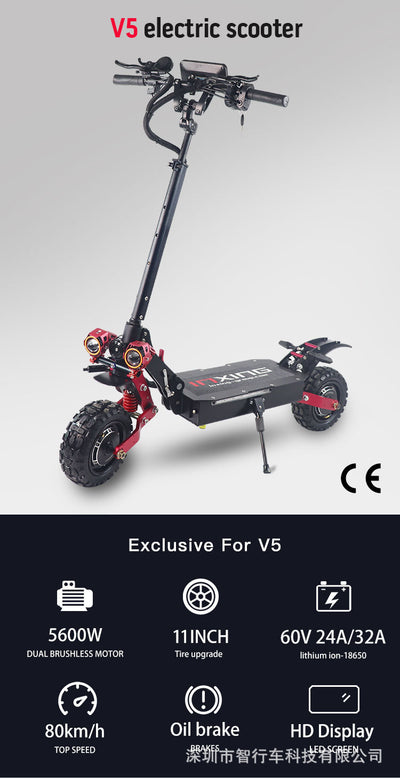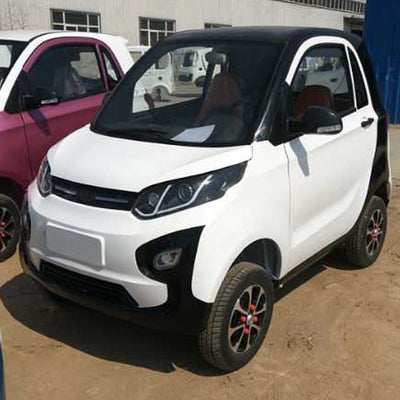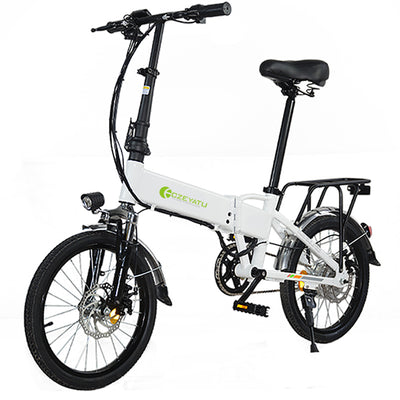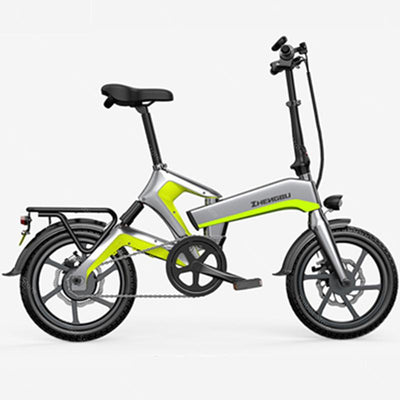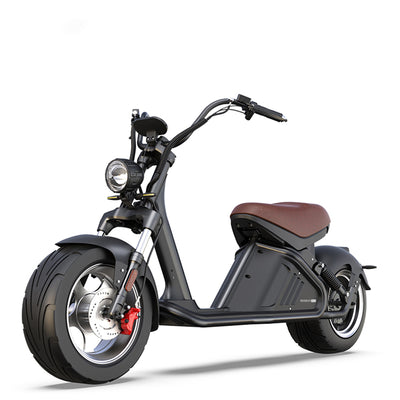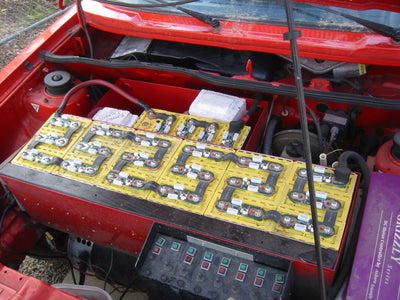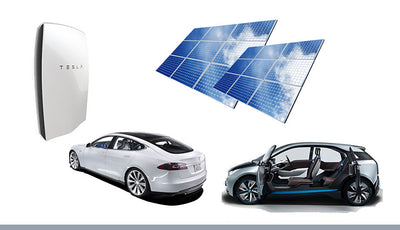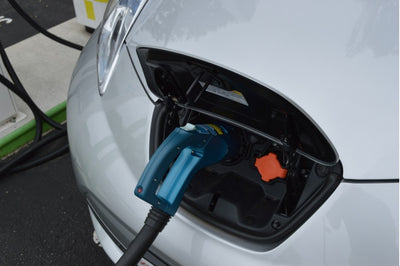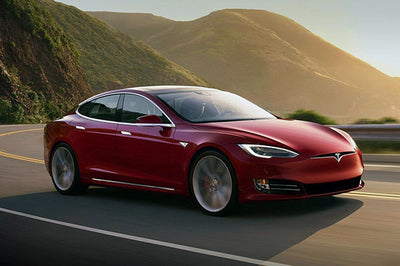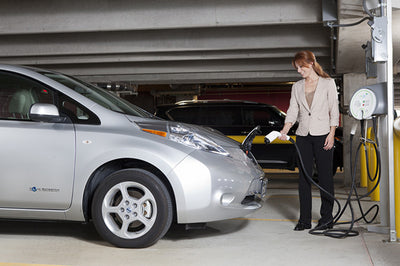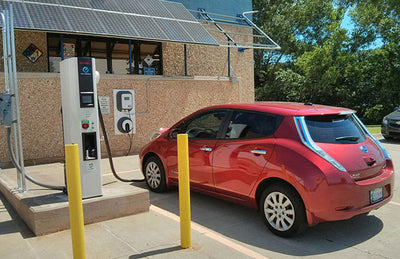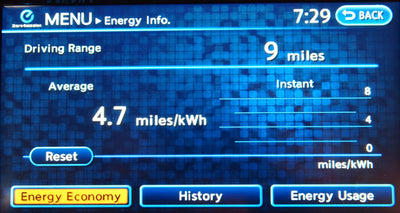Combining Solar Panels with an Electric Car
Posted by Tom Lee on

For most electric car drivers, it’s only a matter of time before this idea pops up: Why don’t I install solar panels so I can run my car on sunshine? Our research suggests that approximately one in three EV owners have solar panels that can generate electricity at home.
The one-two punch of EV and PV (photovoltaic) creates the possibility of breaking the ties between driving and burning fossil fuels—including the coal, natural gas or other non-renewable energy sources used by utilities to produce electricity.
Let’s quickly dispel a few common misconceptions about EVs and solar energy:
-
The solar panels on your roof do not always literally charge your car.
When your home photovoltaic system is producing power during the day, any appliance that’s running in the house—light bulbs, television or an EV charging station—is directly fed by solar power. But even when you charge at night—as you should, because it’s often cheaper and greener—your electric car is benefitting from clean home-produced electricity. Here’s the reason: the PV system is tied into the grid—pumping excess electrons into the broad reservoir of energy shared by all utility ratepayers. Think of the grid as an energy bank, where you deposit green power whenever you can, and pull out those eco-friendly electrons when you need it.
-
Solar on top of your car is a non-starter.
Given the efficiency of solar panels and the relatively limited size of a car’s roof, the amount of energy that can be produced by putting photovoltaics on your car’s roof isn’t going to help much. Covering the 1.5 or so square meters of your EVs roof, on a good sunny day, might generate enough energy for a couple miles of driving—even after a full day of production. There are technology concepts—like the one used by Ford on a C-Max Energi plug-in hybrid—to increase output for a dozen or so miles. And you’ve probably seen futuristic lightweight low-speed solar concept cars with huge roofs to increase surface area. But the smart approach is to use state-of-art home rooftop solar to put enough clean energy into the grid to offset what you’re using to charge your car. Meanwhile, the small solar spoiler on the Nissan LEAF is good for the relatively minor task of recharging the car’s 12-volt battery used to run some vehicle accessories.
Environment and Economics
In many regions of the country, electric utilities heavily rely on coal and natural gas as a source. This fact inspires a viewpoint that—depending on the model for calculating emissions of greenhouse gases or other pollutants—EVs are not so much greener than a Prius-like hybrid, or for that matter, a small fuel-efficient internal combustion car like a Ford Fiesta.
Solar panels on your roof can put a quick end to this debate. Any questions about an electric car’s green-ness from friends, co-workers, and children learning about energy lifecycle issues in school can be addressed by pointing to the photovoltaic array. Look ma, no carbon. (Of course, you’ll probably still encounter cradle-to-grave arguments about the detrimental energy impacts of producing the solar panel hardware and EV batteries.)
But even if the environmental question is somewhat settled, debates on the economics of EV and PV are less easily resolved. The traditional argument against both solar panels and electric cars is that you are paying more upfront—on expenses that might take years, decades or forever, to pay back in reduced home energy and gasoline expenditures. So, by buying an electric car and installing solar, you are essentially doubling down.
Light-tight arguments for or against these investments are elusive. As usual, the devil is in the details—with a broad set of variables, including:
- the specific utility rate in your region (huge factor)
- how much you drive
- amenities of the vehicle
- amount of energy you use at home
- amount of sunlight that hits your roof
Now add all the uncertainties regarding financing plans for both your car and home solar installation—juxtaposed against unpredictable and unstable oil prices, as well as complicated electricity costs. Finally, and perhaps most importantly, there is the resale value of an electric car. Even if upfront costs are not recovered during the period of ownership—by cheaper fueling and maintenance—any premium is commonly recouped when the car is sold to its second owner. Similarly, the value of your home is often increased after adding solar panels. It’s a home amenity (like granite countertops), but one that saves money each month.
Keep in mind that for EV drivers, the cost calculation for solar panels shifts from displacing the expense of utility-supplied electricity to displacing the expense of roller-coaster gasoline prices. And at the point when you’ve paid off your home solar system, the energy generated for your car becomes free.
This article was not written to convince you to go solar. Instead, it is targeted to the many EV buyers, who are already convinced that electric cars or solar panels are smart long-term investments.
Finding an Installer
Unless you are the hardcore DIY type, you’ll need to find a solar installer to manage your home power project. These installers—we recommend independent operators rather than box store solutions—will guide you through every step of the process, including:
- deciding if home solar is right for you
- choosing the best hardware
- finding the best placement on your roof or property
- managing financing and incentives
Start by compiling a list of at least three or four prospective installers, based on Yelp and other online reviews, as well as word-of-mouth referrals from family and neighbors. These installation companies get bonus points for experience with (or interest in) electric cars.
Cost is obviously an issue, but keep other factors in mind—such as trust that your installation will continue to efficiently run for the next 25 years and that the installer will be your go-to guide to get answers to all your questions. A good installer will act like a partner in the entire process.
Sizing
One rule-of-thumb is that a photovoltaic system with an output of 2.5 kilowatts is generally the right size for a household adding the load of an electric vehicle. That’s the size selected by Ford and SunPower—a leading manufacturer of next-generation solar panels—for a special bundled deal for solar panels to power a Ford Focus Electric car. (SunPower offers a $1,000 rebate to customers who buy a Ford plug-in car.)
Those companies estimated that the average output of the 2.5 kW system is about 3,000 kilowatt-hours per year. If you use a somewhat generous basis of four miles of driving for every kWh of electricity put in your car, then it means about 12,000 miles of driving powered by the sun.
Of course, you will want to generate power not only for your car but also for your home. The installation company, and/or the solar info team at your local utility, can study your past power bills to determine how much energy, down to the kilowatt-hour, you are currently using. In the end, you might decide to save money by installing enough solar panels for only a portion of your charging or home power usage. Expect to need approximately 400 square feet of roof space to power both your home and your car.
Regardless, knowing how much power your home and car requires is the first step.
Competitive Bids
With a list of installers in hand—and a target size in mind—you can begin to request bids for your solar project. Each proposal will likely reflect a slight variation in terms of hardware, location, photovoltaic technology, and price. Don’t rush the process. Instead, use the proposals to do your own research, and to compare the differences between different bids both in dollars and technology strategy. Solar technology is changing fast—so again, you’ll need to put some trust in your installation provider, while vetting its assumptions online and with family and friends that already took the leap.
Installation
The solar installer will logically handle all installation tasks, which will take at least a few days. That’s the physical installation. The entire process, from ordering to permitting, can take several weeks or even a couple months, depending on local bureaucracy.
If you are planning to install solar panels and a home EV charger, the most cost-effective and logistically advantageous time to simultaneously install these systems. is simultaneously
Installing a photovoltaic system and an EV charger are both electrical projects. They both require planning, permitting, accessing circuits, selecting and mounting equipment, running conduit and electrical wire, and in some cases, special trenching and construction. Similarly, the number of breakers and the overall electrical service requirements should be considered, as much as possible, in one pass, to avoid bringing back crews or adding equipment after an initial installation.
Incentives
Buyers of electric vehicles that have a battery pack of 16 kilowatt-hours or higher currently qualify for a federal tax credit of $7,500. EVs with smaller batteries also qualify for a federal tax credit, but on a sliding scale based on the size of the car’s battery pack. There are commonly additional perks available at the state level.
If this sounds complicated, prepare yourself for even more rules and variations in solar incentives. Seek guidance from your installer, and keep in mind that solar leasing deals will have a built-in component that reduces your costs—without requiring that you personally apply for any available rebates. Read on.
Solar Leasing
The recent rise in home solar can be credited to the widespread availability of leasing plans allowing little or money down on panels and installation. How does it work? A third-party solar-specific finance company devises a plan that reduces your upfront cost while keeping your electricity costs the same (or close to the same) as it was before you installed solar. The rates are locked in for a decade or more—a period of time in which the panels are monitored (and guaranteed) to produce a certain amount of energy.
These plans are effective for the finance company because it immediately pockets rebates and tax credits—while over time depreciating the value of the system (which they own and you rent). It’s somewhat similar to the lease of an electric car, which has a lower monthly payment because the dealer applied the incentive to the cost basis.
In general, solar leasing (which involve finance charges) makes more sense for people with larger homes, higher energy bills, and heavy use of an electric vehicle.
Warranties
Warranties to ensure that PV continues production levels (monitored via the web) are commonly built into financing contracts, such that the financing company ensures that a system will maintain its quality over decades of use. Most panels have either a 20- or 25- year warranty at the end of which they are expected to produce about 80 percent of the power compared to when they were new.
Utility Rates
Time-of-use (TOU) pricing is one of the most effective tools utilities are employing to discourage EV charging during peak hours, and instead incentivize charging during the middle of the night. Many solar customers are aware of TOU because it has similarly been used to reward households that produce an excess of energy during the day, that can be “sold” back to the utility when the rates are high, and “bought” (or utilized) during cheaper off-peak periods.
Thanks for help on this article from August Goers, vice-president of engineering, for Luminalt, a leading provider of solar solutions in Northern California.



